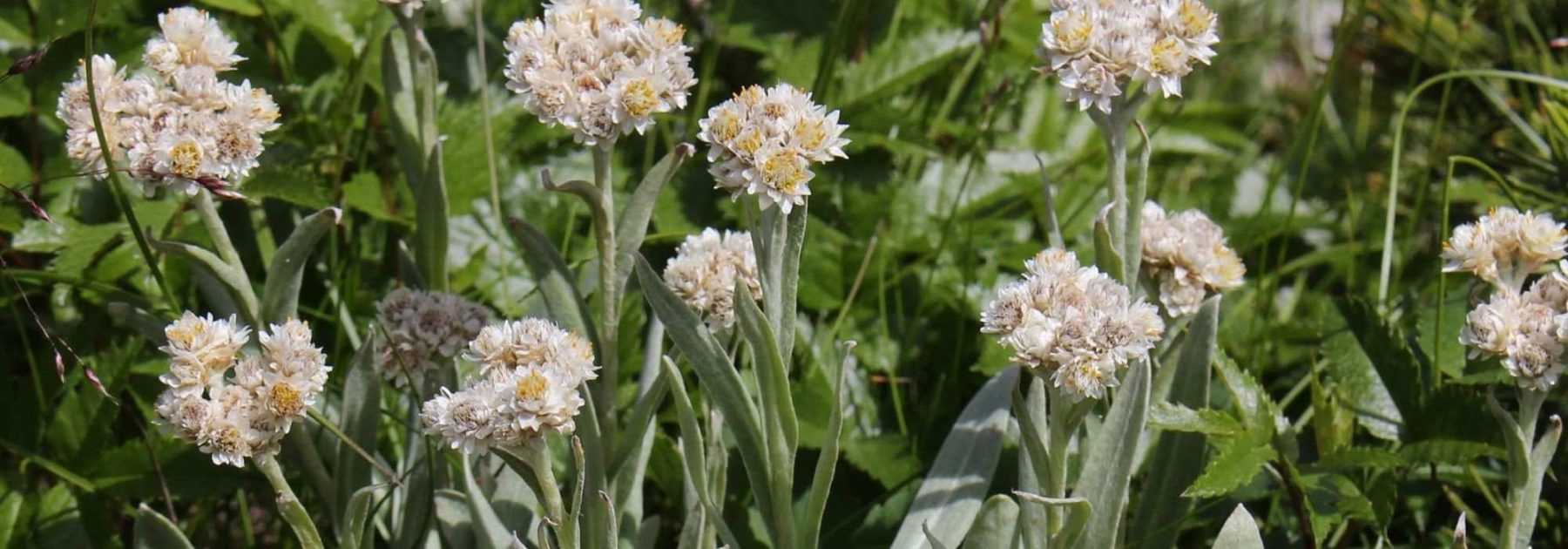
Anaphalis, Pearly Everlasting: Planting, Growing, and Care
Contents
Anaphalis in a few words
- Anaphalis is a rhizomatous perennial with a natural look and very easy to grow
- Its deciduous, grey and often downy foliage forms lovely luminous cushions
- Its white flowering brightens up summer borders, lasting right into autumn
- This perennial is renowned for use in both fresh and dried bouquets
- Drought-resistant, it thrives in well-drained soil and full sun
- Hardy and disease-free, it attracts numerous pollinators
Our expert's word
The Anaphalis is a perennial with many qualities. It is valued for its ease of cultivation, making it an ideal plant for inexperienced gardeners or challenging planting sites. The few ornamental species cultivated have a dense, cushion-like habit, more or less upright. Known by various names depending on the species (Pearly Everlasting, Himalayan Everlasting, Alpine Pearly Everlasting), Anaphalis spreads by rootstocks, making it an excellent ground cover. The flowering, which lasts from summer to autumn, consists of heads made up of numerous small flowers with yellow centres and many papery, pearly bracts. These emerge from deciduous, grey to silvery foliage, often covered in fine hairs. Beautiful in full bloom, it is also highly prized for bouquets, both fresh and dried, and remains decorative for a long time. Very hardy, it tolerates drought well once established, though fresh soil during the season is beneficial. However, it requires perfectly drained soil in winter to prevent root rot. It thrives in sun or partial shade and stands out in rockeries, borders, or beds. It fits well in natural gardens, and its soft, neutral tones can also temper more vibrant colour schemes. Never prone to disease, it requires very little care.
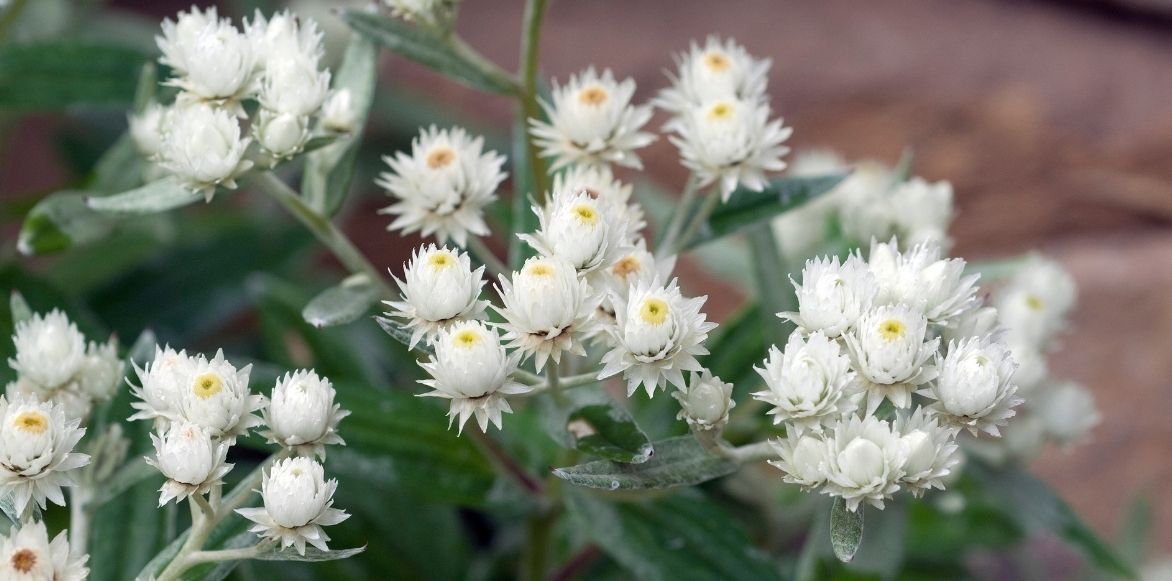
Description and botany
Botanical data
- Latin name Anaphalis
- Family Asteraceae
- Common name Pearly Everlasting, Himalayan Pearly Everlasting, Alpine Pearly Everlasting
- Flowering July to September
- Height 25 to 70 cm depending on species
The Anaphalis refers to a genus belonging to the large Asteraceae (or Compositae) family, which includes among others Asters, Marigolds, Tarragon and even Dandelions.
While there are around a hundred species, only a few are cultivated in our gardens.
The distribution range of this genus covers the Northern Hemisphere (America, Europe, Asia), where Anaphalis grows spontaneously in temperate climates. It can be found in various biotopes, from alpine meadows, rocky or sandy areas, dry woodlands, dunes, lakesides, to dry prairies and clearings. In common language, it is named differently depending on the species. We can mention Pearly Everlasting (Anaphalis margaritacea), Himalayan Pearly Everlasting (Anaphalis triplinervis) or Alpine Pearly Everlasting (Anaphalis alpicola), but other names can also be encountered, such as Western Pearly Everlasting or Marguerite Anaphalis.
Depending on the species, Anaphalis forms a ground cover about twenty centimetres high or takes on a more upright form, reaching around 60 to 70 cm.
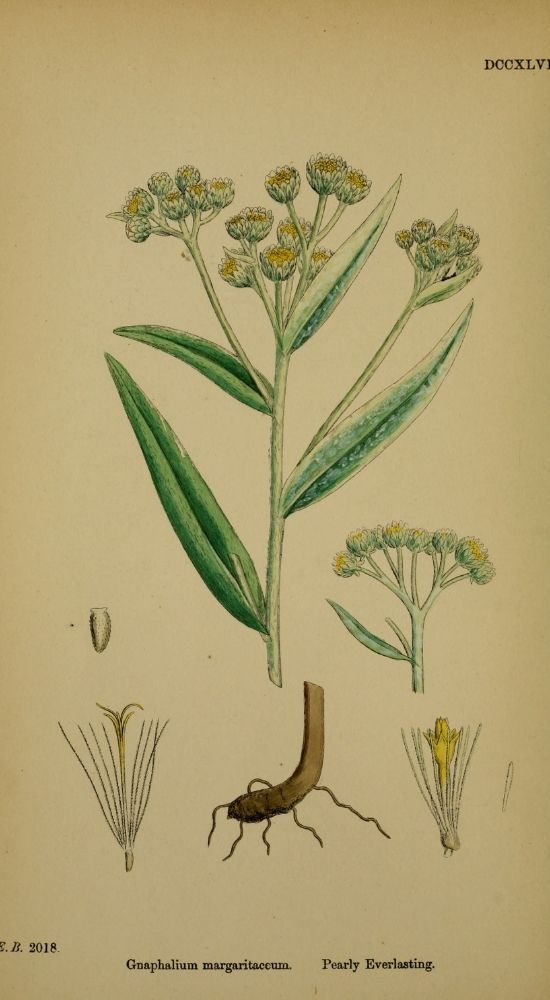
Anaphalis margaritacea (photo Wikimedia – Alice Chodura)
The foliage, arranged in basal or terminal rosettes, is one of the assets of this very easy-going perennial, ideal for beginner gardeners or difficult areas of the garden. Deciduous, it is pale green to silvery grey, sometimes appearing almost white depending on growing conditions and exposure. It is more or less tomentose or pubescent, meaning covered with a silky down, resembling fine hairs. Sometimes, only the underside is hairy, while the upper side is almost glabrous. The alternate leaves are quite narrow and elongated (1 to 15 cm), ovate to lanceolate, sometimes spatulate with incurved edges. They are borne on a usually sheathing petiole, attached to short, erect and sometimes rather thin stems. The lamina is marked with prominent longitudinal veins, solitary or in threes (Anaphalis triplinervis).
Flowering occurs between July and September, with a multitude of small flowers grouped in heads, emerging from the foliage. Each flower is organised around yellow tubular florets that are fertile, surrounded by several rows of fine, dry, white to silvery bracts with a pearly appearance. Depending on the species, these flower clusters may resemble the inflorescences of yarrows or everlastings (Helichrysum). The flowers attract pollinators, and the foliage serves as an egg-laying site for the American Painted Lady (Vanessa virginiensis), a butterfly found in North America, the Canary Islands and Madeira. Highly prized in floral arrangements due to its long vase life, Anaphalis is also excellent for dried bouquet compositions. Left in place in the garden, the inflorescences remain very decorative at the end of the season, naturally complementing autumn scenes. Mostly dioecious, the plants develop either male or female flowers.
Anaphalis is a low-maintenance, hardy perennial (-18°C and beyond), with no notable pests or enemies. It is renowned for its longevity. The only thing it fears is excess winter moisture, which can rot its roots. A plant of sun or partial shade, it appreciates not too acidic soils, fresh to dry, and will grow in low-fertility ground. Anaphalis margaritacea is the most drought-resistant species in the genus.
Easy to propagate by division, it forms beautiful ground covers that spread via their rootstocks, without becoming invasive. It’s an excellent choice for flowering a rockery, embellishing a border, and it fits perfectly in a natural garden or one with a deliberately wild appearance. It also has its place in a cutting garden or one designed to attract pollinators.
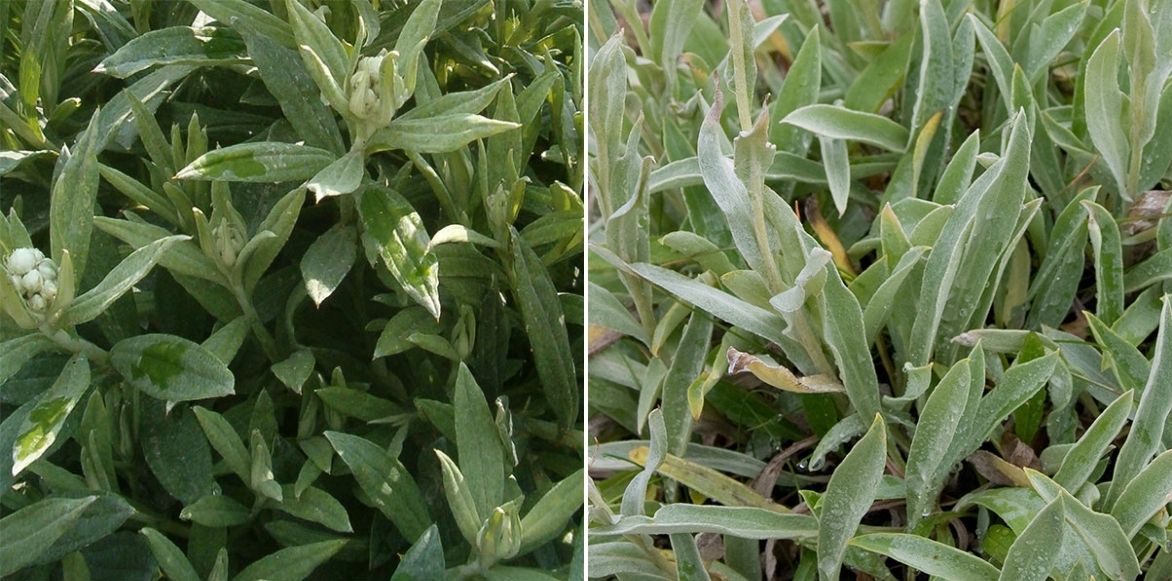
More or less grey leaves of Anaphalis triplinervis ‘Sommerschnee’ and Anaphalis alpicola

Flowers of Anaphalis triplinervis (photo Gustaf Eriksson – Wikimedia), caterpillar and butterfly Vanessa virginiensis (photos Jacy Lucier – Wikimedia and Mike Goad – Flickr)
The different species and varieties
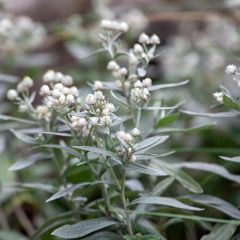
Anaphalis triplinervis
- Flowering time August to October
- Height at maturity 40 cm
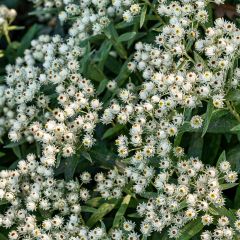
Anaphalis triplinervis Sommerschnee
- Flowering time August to October
- Height at maturity 30 cm
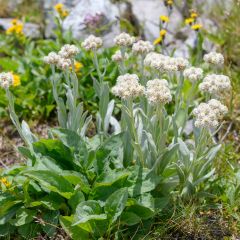
Anaphalis alpicola
- Flowering time August, September
- Height at maturity 25 cm
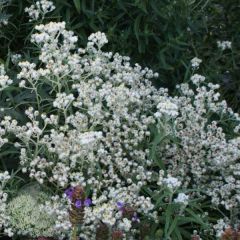
Anaphalis margaritacea Neuschnee
- Flowering time August to October
- Height at maturity 60 cm
Discover other Anaphalis
View all →Available in 1 sizes
Available in 1 sizes
Available in 1 sizes
Available in 1 sizes
Planting
Where to plant?
Anaphalis is a very easy-to-grow perennial, suitable for both novice and experienced gardeners. Choose a sunny or partially shaded spot. Thriving in calcareous soils, it can also adapt to neutral soil. In any case, effective drainage is essential to prevent waterlogging in winter. Therefore, light, sandy, or stony soils suit it perfectly. Although drought-tolerant once established, Anaphalis appreciates occasional watering in summer.
Highly hardy, it can be planted in all gardens and suits various landscaping styles. It can add grey and silvery tones to rockeries that aren’t too hot or highlight a border in a flower bed. Its no-fuss look also makes it ideal for naturalistic gardens, in beds or laid-back or slightly wild meadows. The edges of a natural pond provide both the drainage and coolness it enjoys.
Growing it in pots or troughs allows you to enjoy it anywhere, including on a terrace, patio, or balcony.
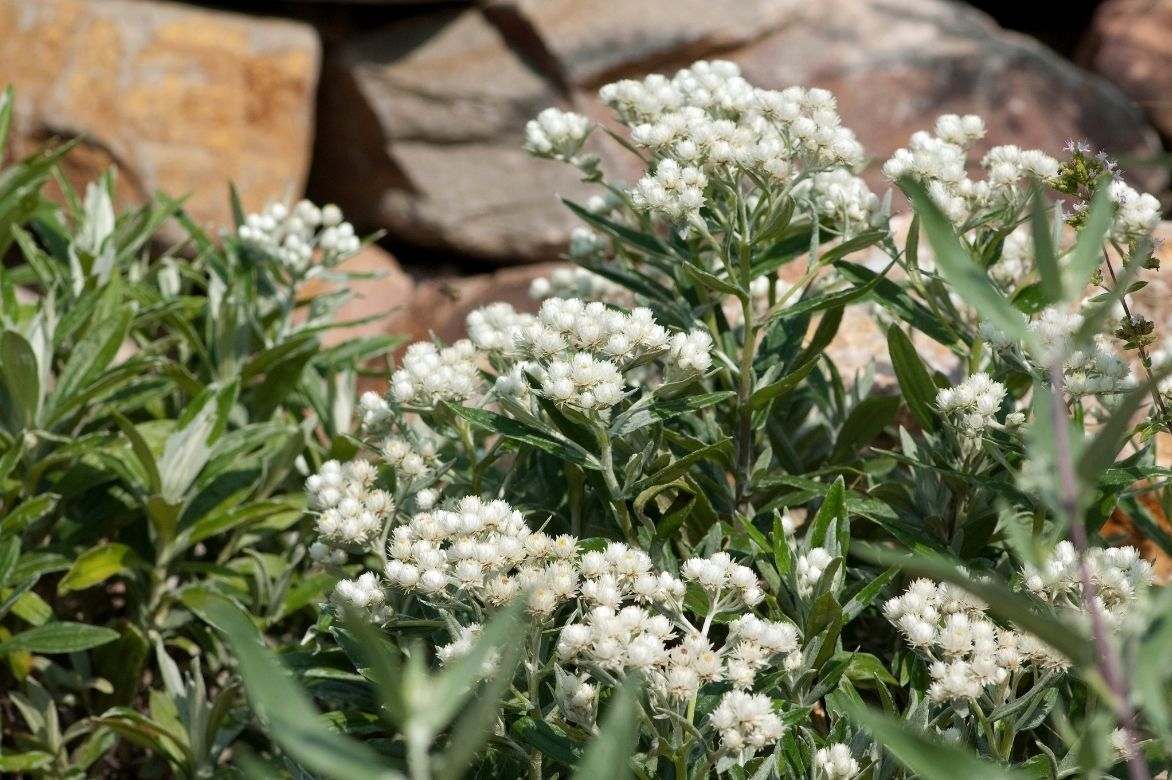
When to plant?
Potted plants can be planted year-round, except during extreme drought or frost, but autumn remains the best time. In very cold and wet regions, late winter or early spring may yield better results.
How to plant?
- Soak the pot in enough water to saturate the entire substrate.
- Meanwhile, dig a hole 2 to 3 times the size of the container.
- Loosen and crumble the soil.
- In heavy soils, improve drainage with suitable materials (gravel, coarse sand, clay pebbles, etc.). If your soil is very poor and coarse, add compost.
- Remove your young plant from its pot and place it in the centre of the hole, then fill in with the substrate.
- Firm gently, and water to eliminate air pockets around the roots.
- Mulch with your chosen material (organic or mineral).
- In the first few weeks, ensure the soil doesn’t dry out too much, but avoid waterlogging the plant.
In pots, add a drainage layer at the bottom of the container, and use a light mix, such as potting soil mixed with sand, adding a handful of compost.
Maintenance
- The Anaphalis is a young plant that requires very little care. Make sure not to let the soil dry out too much during periods of intense heat.
- The dried stems and flowers remain decorative for a long time, and they shelter a whole host of beneficial microfauna. Only cut them back when their aesthetic appearance no longer satisfies you, or tidy up the clump at the end of winter, before new growth resumes.
- Check the mulch regularly, and top it up if necessary.
- In any case, there’s no need to protect your Anaphalis in winter, as it is very hardy, and primarily fears excess moisture during the wet season.
Propagation
Dividing the clump is the simplest method to propagate Anaphalis. This can be done in autumn or early spring.
- Dig up your young plant using a spade. Be sure to keep some roots with a bit of soil.
- Divide the young plant into several sections with a sharp tool.
- Replant in the desired location.
- Top up with suitable compost and firm gently.
- Water generously, then mulch.
- Ensure the soil does not dry out too much in the first few months, giving the young plant time to develop a strong root system.
Pairing Anaphalis
The Anaphalis offers both foliage and flowering that bring light and a natural touch to any garden.
- In a rock garden, its silvery-grey foliage complements other plants with similar hues, such as Artemisia, Achillea kellereri (with visually similar but earlier flowering), or Sea Kale. The aromatic, greener foliage of rosemary provides initial contrast, while its blue flowers brighten winter months or the growing season, depending on the variety. Add splashes of additional colour with perennials such as Columbines, Pinks, subulate Phlox, Aubrietas, Sedum, Saxifrages, or Bellflowers. Create accents with ornamental grasses that sway gracefully, such as the elegant Stipa pulcherrima with its infinitely graceful spike, or the well-known Angel Hair.
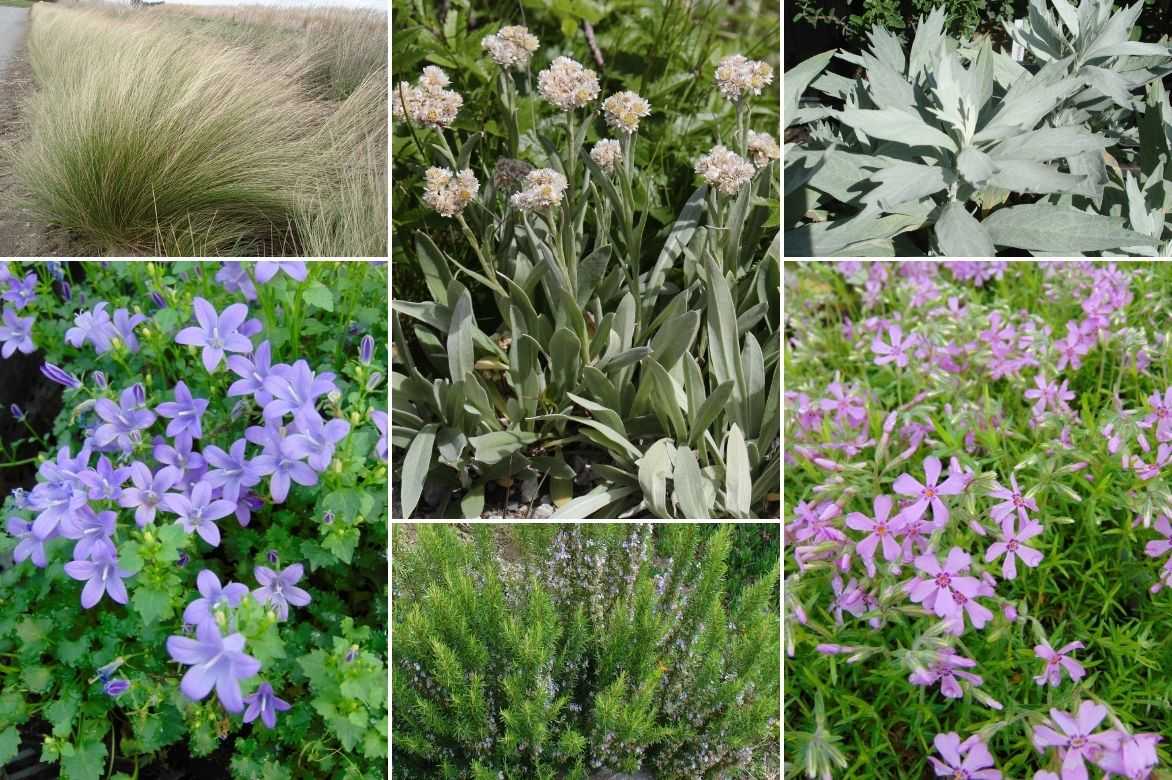
Anaphalis alpicola alongside Stipa tenuifolia, Campanula muralis, Rosmarinus officinalis, Artemisia ‘Valerie Finnis’, and Phlox subulata ‘Moerheimii’
- The Anaphalis enhances the natural, relaxed feel of borders, alongside tall perennials like Knotweeds, Asclepias, Baptisias, Echinops, Blazing Stars, or certain Sages. Its small clustered inflorescences also create a lovely contrast with Hybrid Tea Roses or cluster-flowered roses. Once again, ornamental grasses help tie everything together and add movement, especially when a gentle breeze drifts through the garden.
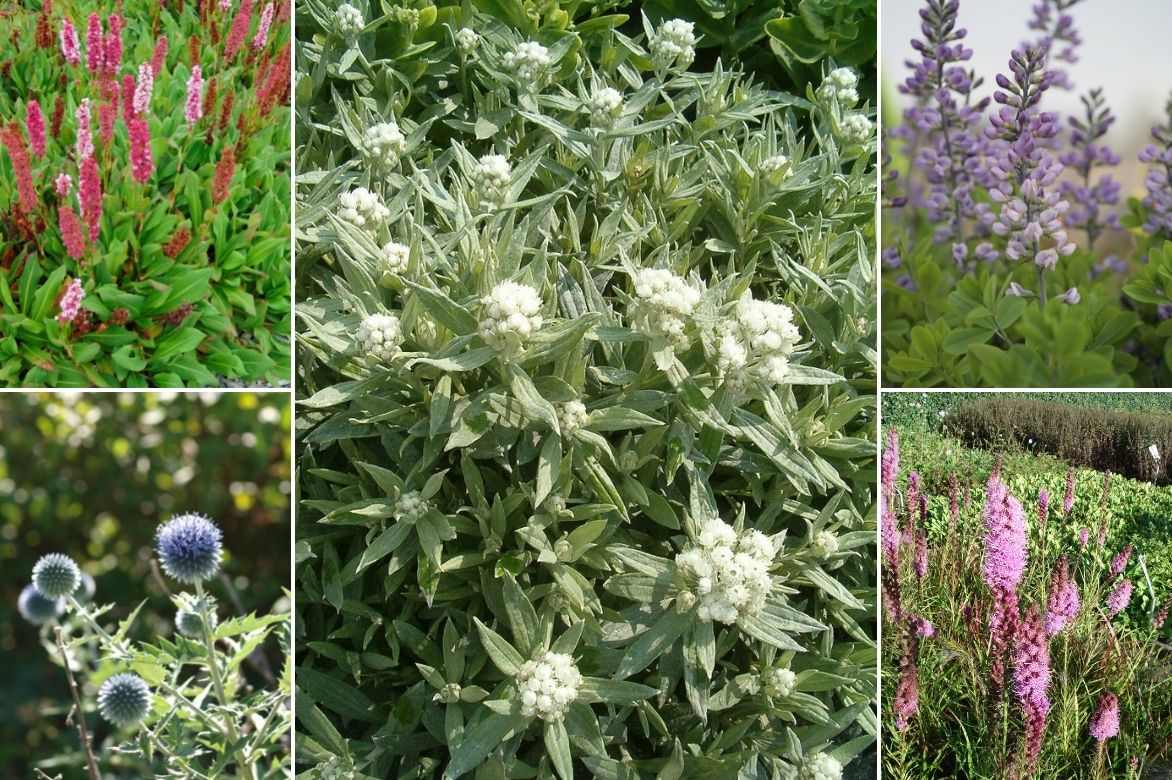
Anaphalis ‘Sommerschnee’ (Wikipedia photo) surrounded by Persicaria ‘Kabouter’, Baptisia, Echinops (photo FD Richards), and Liatris spicata
- The Anaphalis is an excellent perennial for bouquets. For fresh, cottage-style arrangements, pair it with Baby’s Breath, perennial Daisies, Cosmos, Marigolds, and Rudbeckias. For dried flower arrangements, mix it with Honesty, Sea Lavender, Sea Hollies, and don’t forget to include a few spikes of ornamental grasses such as Briza media.
→ Discover more pairings with Anaphalis
Did you know?
- The Anaphalis has medicinal properties. Native Americans used it in the form of fumigation to combat coughs, and it was one of the plants used in making peace pipes.
- In Quebec, it is sometimes used in various preparations to soothe burns or fight colds.
Useful resources
–> Discover our different species and varieties of Anaphalis in our online nursery.
–> All about dried flowers: choosing, drying, maintenance.
–> All our advice for creating a cutting garden!
- Subscribe!
- Contents






































Comments